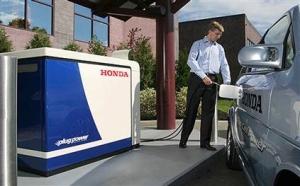 Researchers at Oregon State University have discovered an efficient way to produce hydrogen power using biowaste like municipal sewage. The innovative process uses 75% less energy than the traditional method of producing hydrogen, and can be done at a much lower cost.
Researchers at Oregon State University have discovered an efficient way to produce hydrogen power using biowaste like municipal sewage. The innovative process uses 75% less energy than the traditional method of producing hydrogen, and can be done at a much lower cost.
The new approach could utilize several types of biowaste, including manure, wood waste, or sewage, to produce hydrogen at a much lower cost than the traditional “electrolysis” technology, making it attractive for use in hydrogen fuel cells that could power the non-polluting automobiles of the future.
“In the laboratory we’re already quite close to the Department of Energy hydrogen cost goal of $2 to $3 per gasoline gallon equivalent,” said Hong Liu, an OSU assistant professor of biological and ecological engineering. “And with some additional research it should be possible to scale these systems up to levels needed for commercial use.”
But that’s not even the best news.
While it’s producing significant amounts of hydrogen from sewage, this system also cleans the water. Conceptually, treatment plants could be developed that take in sewage on one end and send clean water and hydrogen fuel out the other. Their production potential may only be limited by the amount of raw waste they have available – and sewage in the future may no longer be a waste disposal problem but rather a valued commodity, another important component of the nation’s sustainable energy equation.
Other forms of biowaste could also be used, scientists say. The use of woody biomass is possible. The large amounts of waste from food processing factories would be a good candidate, as well as agricultural waste such as the huge amounts of manure produced in cattle, hog, and other livestock operations. In that context, it may be quite possible to make a silk purse out of a sow’s rear.
All of this was achieved through fundamental research on “microbial electrolysis cells,” or MECs, that use a new “membrane free” approach that costs less and is significantly more efficient than existing approaches.
The findings have just been reported in Water Research, a professional journal, by researchers in the College of Engineering at Oregon State University.
“The removal of membrane not only can simplify the construction, operation and maintenance of MECs, but it also can decrease the internal resistance, thus increase the hydrogen production rate,” the researchers said in their report.
In these systems, naturally occurring microorganisms from sewage attach to the surface of an anode and degrade the waste in the sewage, in a device that is something like a battery. The waste decomposes, eventually leaving protons that migrate to the cathode, combine with electrons and generate hydrogen.
 These systems can be adapted to generate electricity directly or used to produce hydrogen, which in turn can be used to produce electricity from hydrogen fuel cells – an existing and widely proven technology.
These systems can be adapted to generate electricity directly or used to produce hydrogen, which in turn can be used to produce electricity from hydrogen fuel cells – an existing and widely proven technology.
“Hydrogen has often been thought of as the ideal fuel to run fuel-cell powered automobiles,” Liu said. “Hydrogen fuel cells are about 60 percent efficient, roughly double that of a gasoline internal combustion engine. And there is no air pollution; the only byproduct from operation of the fuel cell is water.”
One of the biggest steps still needed to make this type of fuel cell vehicle a reality is solving hydrogen production issues – and the new technology developed in Liu’s laboratory might produce hydrogen at a cost close to the DOE goal. Those cost figures do not include the potential savings of billions of dollars spent in treating the nation’s wastewater, which further increase the economical viability of the technology.
“Another interesting application of this approach might be in developing countries or remote areas,” Liu said. “Often these places have few or no waste treatment plants, and no practical way in a remote location to produce electricity. Small systems used there might solve both problems.
“There’s no doubt this could help contribute to a more sustainable future,” Liu said. “We could clean up our sewage and produce fuel at the same time. That’s very promising.”




















Sign me up!
yahoo! we can now heal our collective subconscious and potty trainings gone awry by feeling that we can love our poo!!!